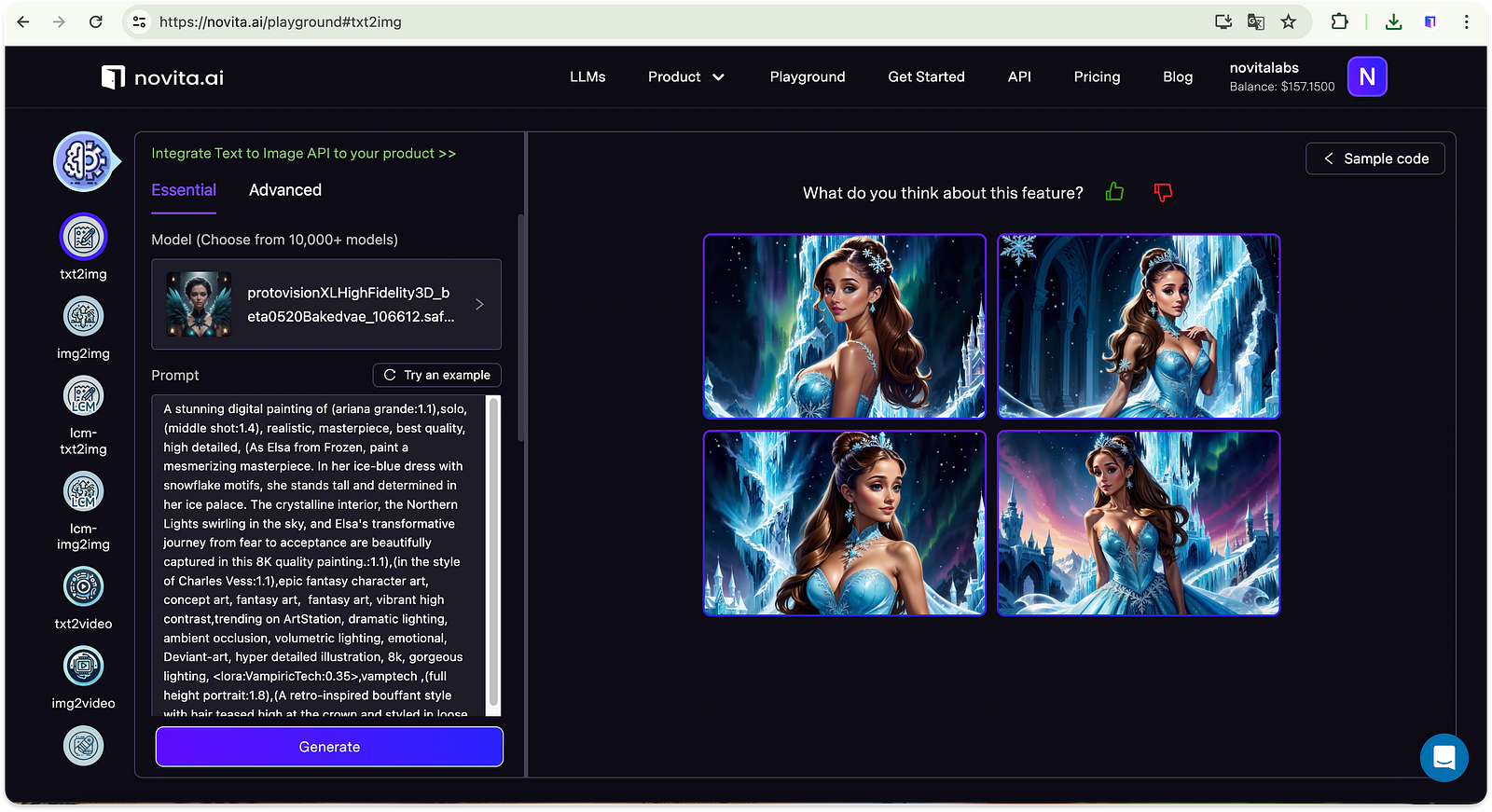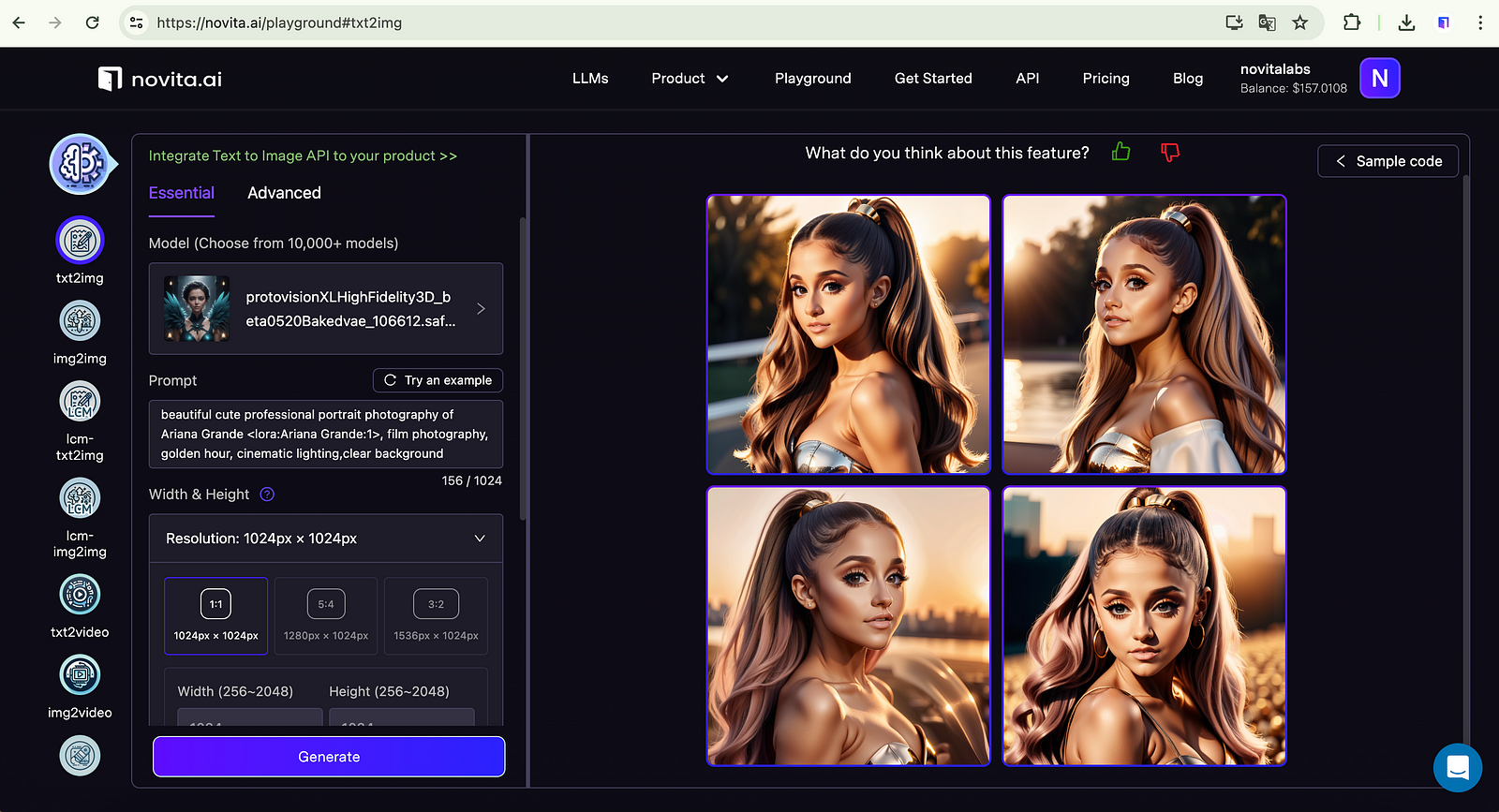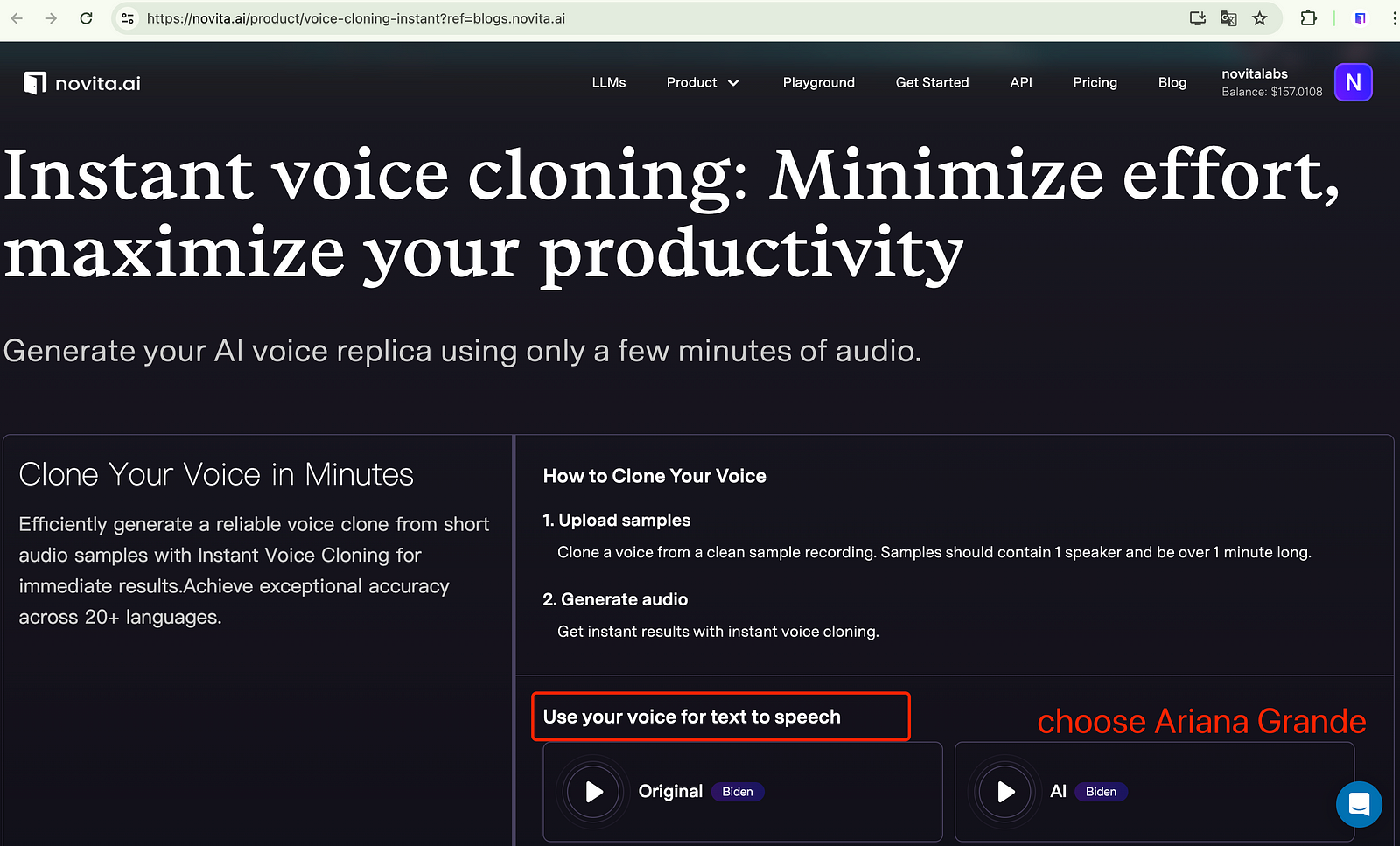Mastering Ariana Grande Deep Fakes: Insider Secrets Revealed

Master the art of creating Ariana Grande deep fakes with our insider secrets. Elevate your deep fake skills with our blog.
Key Highlights:
- Ariana Grande: Renowned pop sensation celebrated for her music and acting prowess.
- Understanding Deepfakes: AI-driven technology alters videos/images by swapping faces, with diverse applications.
- Rise of Celebrity Deepfakes: Celebrities like Ariana Grande are popular subjects for deepfakes, posing ethical challenges.
- Next-Level Audio Innovation: novita.ai’s Text-To-Speech and Voice Clone APIs offer advanced APIs for deepfake creation tool.
- Legal and Ethical Issues: Deepfake creation raises privacy and consent concerns, emphasizing ethical use.
- Detecting Deepfakes: AI-powered tools analyze content for manipulation signs to combat misinformation.
Introduction
Ariana Grande, a global pop sensation renowned for her musical prowess and versatile talents in entertainment, has captured the hearts of millions worldwide. As deepfake technology continues to evolve, enthusiasts are delving into the creation of hyper-realistic videos featuring Ariana Grande, blending her iconic persona with cutting-edge AI advancements. However, amid the fascination surrounding deepfake creation, it’s imperative to navigate the legal and ethical complexities inherent in this practice. From understanding the basics of deepfake technology to leveraging innovative APIs for audio synthesis, the journey to crafting Ariana Grande deepfakes is both intriguing and fraught with ethical considerations. As we explore the intricacies of this phenomenon, let’s delve deeper into the realm of deepfake technology and its implications for creators, consumers, developers, and society at large.
Who is Ariana Grande?
Ariana Grande, a pop sensation renowned for chart-topping hits such as “Thank U, Next,” has established herself as a versatile artist excelling in singing, songwriting, and acting. Garnering a vast following on various social media platforms, she has received accolades and recognition for her exceptional musical talents and captivating performances. Apart from her successful music career, Ariana Grande has also delved into acting, showcasing her versatility across different forms of entertainment. Her ability to connect with audiences through her music and performances has solidified her status as one of the most influential figures in the industry today.

Understanding Deepfake Technology
Before creating Ariana Grande deepfakes, learn about the technology behind them. Deepfake tech uses AI and machine learning to realistically alter videos or images by swapping faces. This cutting-edge AI has diverse applications, both positive and negative.

The Basics of Deepfake Creation
Creating a deepfake involves gathering diverse data of Ariana Grande, selecting the right software tools, and preparing images and videos. The final steps include fine-tuning parameters for realism, like facial expressions and transitions between frames.
Evolution of Deepfake Technology
Deepfake technology has transitioned from controversial origins in non-consensual pornography to mainstream popular culture. Smaller online content creators, such as Corridor Digital, have been the main innovators of deepfakes in pop culture. Founded by two geeky guys from Minnesota, Sam Gorski and Nico Pueringer, who moved to Los Angeles to produce viral videos, Corridor Digital has now produced dozens of short deepfake videos on their YouTube channel, showcasing their ability to do visual effects better than Hollywood studios.
When deepfakes emerged, they jumped on the technology and produced a breakout video, “Keanu Reeves Stops A Robbery,” in last year, 2019, demonstrating the potential of corridor digital’s work in the online world. Media giants like Channel 4 and South Park have also explored the potential of deepfakes for engaging content, with even fellow rapper Kanye West using deepfakes in his video for Life of the Party featuring Nipsey Hussle and Kobe Bryant. The increasing embrace of deepfakes in its early years, as its primary use shifts towards storytelling, signals a cultural crossroads in which the technology’s potential for innovative applications, such as Kendrick Lamar’s use of deepfakes in his music video for The Heart Part 5, is being recognized and embraced.
The Rise of Celebrity Deepfakes
Celebrities like Ariana Grande, Kim Kardashian, and Idris Elba are popular subjects for deepfakes, gaining millions of online views. These deepfakes show famous individuals in unexpected and humorous situations, capturing viewers’ imagination with fresh perspectives.
Why Ariana Grande Deepfakes are Popular
Ariana Grande’s deepfakes have captivated fans and garnered attention for blending her fanbase with deepfake technology. These videos offer a fresh way for fans to engage with her music and persona, spreading virally on social media and video-sharing platforms. The popularity of these deepfakes stems from her fanbase, the allure of the technology, and online platforms facilitating their reach.
Ethical Considerations in Celebrity Deepfakes
The ethical implications of celebrity deepfakes are significant. They can harm individuals’ reputations and privacy by distorting reality. While in comedy and entertainment, deepfakes can offer light-hearted amusement when used appropriately. However, the major ethical issue with deepfakes is the idea that they’re trying to trick us — a problem that can arise when they are used for malicious purposes. As deepfake technology advances, it’s crucial to establish guidelines for their cultural use, including the consideration of ethical concerns raised by creators like Trey Parker and Matt Stone, who used deepfakes in their fictitious host, consumer advocate Fred Sassy, played by a deepfake Donald Trump, in their spoof consumer rights program, Sassy Justice, to ensure responsible engagement.
How Deepfakes Are Made
Deepfakes are made by collecting data and using specialized software tools. Video footage and images of the target person, such as Ariana Grande, are collected to train deepfake models. Various software tools designed for deepfake technology are used to generate these models. Editing techniques can then be applied to enhance realism, with adjustments made to achieve the desired result. Careful data collection and advanced software tools are essential for creating a convincing Ariana Grande deepfake.
Gathering the Right Data
To create an authentic Ariana Grande deepfake, gather high-quality video footage and images from interviews, music videos, and public appearances. Diverse data sources enhance the deepfake quality, and the use of artificial intelligence can assist in analyzing and categorizing visual content for selecting relevant data to train the model ethically and legally while respecting privacy and rights.
Choosing the Best Software Tools
Choosing the right software tools is crucial for high-quality deepfakes. Various advanced machine-learning tools generate realistic deepfakes with features like facial detection, alignment, and synthesis for accurate face mapping. Popular tools include Faceswap, DeepFaceLab, and DeepArt. Research and experiment to find the best tool for your needs. Stay updated on the latest deepfake technology advancements for cutting-edge results.
Unlocking Next-Level Audio Innovation
Moreover, if you are a developer, choosing the Best APIs when selecting the right software tools for creating deepfakes, consider utilizing novita.ai’s API, which provides powerful capabilities for generating highly realistic deepfake content. novita.ai offers a user-friendly interface coupled with advanced machine learning algorithms, enabling seamless facial detection, alignment, and synthesis for precise face mapping. By leveraging novita.ai’s API, developers can access cutting-edge technology to produce convincing deepfakes with ease.

Now novita.ai has now released the Text-To-Speech API and Voice Clone Instant API. Text-To-Speech API generates realistic speech in various languages. Voice Clone Instant API clones your voice with only a few minutes of audio. Also the more advanced Voice Clone API is currently in beta, providing more professional voice cloning features

Step-by-Step Guide to Creating an Ariana Grande Deepfake
You can easily understand the process of creating an Ariana Grande Deepfake video through the following steps. If you, as a developer, have a deeper interest in editing such tools, please visit novita.ai for more APIs to unlock greater potential.
Step 1. Head to novita.ai.
Step 2. Use the txt2img tool. Create high-quality images of Ariana Grande with a clear background to ensure a realistic result.

Step 3. Use voice-cloning tool to create Ariana Grande sweet audio.

Step 4. Continue to use Image to Video — Motion tool. On the left side, choose a video template. You can also customize your template. Next, click “+” on the right side to select a face to start creating.
Step 5. Click “Generate” and the video face swap will be in progress automatically. Once completed, you can post a video in the community, download it, delete it, or create it again as needed.

Legal and Ethical Issues
Creating and sharing deepfakes raises legal and ethical concerns. Deepfakes can violate privacy and image rights. Understanding defamation, intellectual property laws, and consent is crucial. Ethical use involves avoiding harm, being transparent, and respecting individuals’ rights and dignity. Awareness of consequences is essential.
Navigating Legal Boundaries
Creating and sharing deepfakes on platforms like TikTok requires understanding and complying with platform policies to avoid content removal or account suspension. Familiarize yourself with guidelines on defamation, intellectual property, and consent to respect individuals’ rights and privacy as outlined in TikTok’s policies. Always read and understand TikTok’s privacy policy before creating and sharing deepfakes on the platform. Stay informed and compliant with their terms of service to navigate legal boundaries effectively.
The Ethics of Deepfake Creation
Deepfakes raise ethical concerns as they can deceive and manipulate visual media, potentially causing harm. It’s important to consider their impact on individuals and society. Ethical use involves transparency, consent, and responsible creation and sharing. Navigating these considerations is crucial for promoting ethical deepfake use in mainstream culture.
Detecting Deepfakes
Detecting deepfakes is crucial as technology advances. AI uses algorithms to analyze inconsistencies in visual and audio content. Tools like digital forensics and machine learning aid in identifying deepfakes by analyzing movements, audio, and visual artifacts. AI advancements improve detection accuracy and reliability.
Tools and Techniques for Identification
Identifying deepfakes requires specialized tools like DeepInspect and XceptionNet to analyze visual and audio content for manipulation signs. These tools detect movement inconsistencies, visual artifacts, and audio discrepancies. Facial recognition algorithms compare facial features to verify authenticity. Here’s a comparison of popular deepfake detection tools and techniques:

The Role of AI in Detecting Deepfakes
AI is essential in detecting deepfakes by analyzing visual and audio content for inconsistencies. Machine learning algorithms compare real and deepfake videos for differences in movements, audio, and visual elements. AI tools evolve to counter deepfake advancements, crucial in combating misinformation and safeguarding individuals. Despite challenges, AI remains pivotal in developing accurate methods to detect deepfakes.
Conclusion
In the realm of deepfake technology, the allure of perfecting Ariana Grande deepfakes has captivated many. From understanding the basics to navigating legal and ethical considerations, the journey to creating these hyper-realistic videos is intricate. As technology evolves, so do the tools and techniques used in deepfake creation. However, amid the fascination, we must not overlook the ethical implications and legal boundaries that surround this practice. Detecting deepfakes requires a keen eye and the aid of advanced AI systems. As we delve into this fascinating yet controversial world, it’s crucial to tread carefully, respecting both privacy and authenticity.
Frequently Asked Questions
Are there legal repercussions for making deepfakes?
Making deepfakes can have legal consequences, infringing on privacy and intellectual property rights. Content creators must respect legal boundaries and obtain consent when creating and sharing deepfakes.
How can one tell if a video is a deepfake?
Identifying deepfakes can be challenging, but advanced AI algorithms can analyze visual and audio content for signs of manipulation. Inconsistencies in facial and body movements, visual artifacts, and audio discrepancies are common signs of a deepfake.
novita.ai, the one-stop platform for limitless creativity that gives you access to 100+ APIs. From image generation and language processing to audio enhancement and video manipulation,cheap pay-as-you-go , it frees you from GPU maintenance hassles while building your own products. Try it for free.
Recommended reading